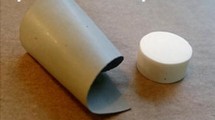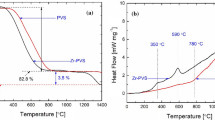Abstract
A modified oxide sol-gel (MOSG) process was used to synthesize borophosphosilicate glasses and glass-ceramics using boron oxide and phosphorous pentoxide as starting precursors. The oxide precursors were used to form alkoxidesin situ, which were then hydrolysed and condensed to form borophosphosilicate gels. The dried gels were analysed for their thermal properties and were heat treated accordingly, at a temperature of 800 °C, to crystallize the boron phosphate phase. The resultant xerogels were then analysed for their microstructure. Both pressureless and hot-pressing techniques were used to sinter the calcined gels to form glass-ceramics. The sintered samples were characterized for their microstructure using electron microscopy and evaluated for their dielectric properties. Dielectric measurements indicate that the sintered glass-ceramics possess dielectric constants less than 5 and dissipation factors less than 0.001 at a frequency of 1 MHz. The results of these studies show the potential of the oxide sol-gel-derived borophosphosilicate glass-ceramics for use as substrate materials in microelectronic packaging.
Similar content being viewed by others
References
R. R. Tummala andE. J. Rymaszewski (eds), “Microelectronic Packaging Handbook” (Van Nostrand Reinhold, New York, 1989).
G. Geiger,Bull. Am. Ceram. Soc. 69 (1990) 1131.
E. M. Rabinovich,J. Electron. Packaging 111 (1989) 183.
R. R. Tummala andR. B. Shaw, in “High Tech. Ceramics”, edited by P. Vincenzini (Elsevier Science, Amsterdam, 1987) p. 75.
J. L. Sprague,IEEE Trans. Compon. Hybrids Manufact. Technol. 13 (1990) 390.
K. R. Kinsman,J. Metals 6 (1988) 7.
J. F. MacDowell andG. H. Beall, in Materials Research Society Symposium Proceedings, “Advanced Electronic Packaging Materials”, edited by A. T. Barfknecht, J. P. Partridge, C. J. Chen and Che-Yu Li, Vol. 167 (MRS, Pittsburgh, PA, 1989) p. 43.
Idem, in Proceedings of the 1st International Science and Technology Conference, Materials and Processes for Microelectronic Systems, “Ceramic Transactions”, edited by K. M. Nair, R. Pohanka and R. C. Buchanan, Vol. 15 (American Ceramic Society, Westerville, OH 1989) p. 259.
P. F. James,J. Non-Cryst. Solids 100 (1988) 93.
J. D. Mackenzie,ibid. 100 (1988) 162.
D. R. Ulrich,ibid. 100 (1988) 174.
H. Schmidt,ibid. 100 (1988) 51.
C. Sanchez, J. Livage, M. Henry andF. Babonneau,ibid. 100 (1988) 65.
J. Zarzycki,ibid. 121 (1990) 110.
M. Nabavi, S. Doeuff, C. Sanchez andJ. Livage,ibid. 121 (1990) 31.
H. Schmidt andH. Wolter,ibid. 121 (1990) 428.
P. N. Kumta, R. E. Hackenberg, P. H. McMichael andW. C. Johnson,J. Mater. Lett, (in press).
P. P. Phule andF. Khairula, in “Proceedings of the Third International Conference on Powder Processing Science”, Ceramic Transactions, Vol. 12, edited by Gary L. Messing, Shin-ichi-Hiraso and Hars Hausner (American Ceramic Society, Westerville, OH, 1990) p. 725.
M. Guglielmi andG. Carturan,J. Non-Cryst. Solids 100 (1988) 16.
F. A. Cotton andG. Wilkinson, “Advanced Inorganic Chemistry”, 5th Edn (Wiley, New York, 1988) pp. 168, 400.
J. C. Brinker andG. W. Scherer, “Sol-gel Science: The Physics and Chemistry of Sol-Gel Processing” (Academic Press, Boston, MA, 1990).
P. N. Kumta andM. A. Sriram,J. Mater. Sci. 28 (1993) 1097.
R. F. Field,Proc. ASTEA Am. Soc. Testing Mater. 54 (1954) 456.
M. A. Subramanian, R. D. Shannon, B. H. T. Chai, M. M. Abraham andM. C. Wintersgill,Phys. Chem. Minerals 16 (1989) 741.
D. A. Skoog, in “Principles of Instrumental Analysis”, 3rd Edn (Saunders College Publishing, New York, 1985) p. 716.
Author information
Authors and Affiliations
Rights and permissions
About this article
Cite this article
Hsu, R., Kumta, P.N. & Feist, T.P. Modified oxide sol-gel (MOSG) synthesis of borophosphosilicate glasses and glass-ceramics. J Mater Sci 30, 3123–3129 (1995). https://doi.org/10.1007/BF01209226
Received:
Accepted:
Issue Date:
DOI: https://doi.org/10.1007/BF01209226




